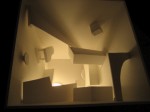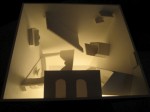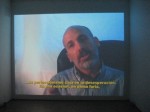The Witches of Tepoztlan
http://www.pintobooks.com/booksintransTheWitches.html
An edgy Italian dandy at the turn of the century throws his piano from his balcony. A Mexican painter from colonial times drinks a potion that allows him to foresee the future.
A famous Syrian video maker dies mysteriously in the streets of Jerusalem. In 1977, a Spanish priest in Seville discovers a manuscript that turns out to be the first opera ever written in the Americas. A black gay composer writes an opera in the 1950s that predicts the downfall of the American empire. Following the dictation of Hermes Trismegistus, Giordano Bruno writes his masterpiece knowing that hey may be burned alive for it. The life of an Israeli soldier ends up in the hands of a small Palestinian girl. A young woman from a New England aristocratic family chooses to be buried alive rather than leaving her life of privilege.”*
*Introduction to the book The Witches of Tepoztlán (and Other Unpublished Operas)
Title at Jorge Pinto Books
This project includes a published book, a video, four dioramas and several works on paper.
The project revolves around the “biographies” and “works” of four opera composers who, according to the artist, “are so deeply forgotten in history that their very identity and their works could be questioned as having been entirely fabricated”. They include Enrico Camorelli (1868-1904), author of Il Processo di Giordano Bruno (The Trial of Giordano Bruno), Mona Kassem (1995-?) author of the minimalist political work Jahannam, Anselmo Jiménez de la Rueda (1593-1674), author of Las Brujas de Tepoztlán (The Witches of Tepoztlán), and Richard Pryce, (1915-1978), author of The Connecticut Story, a work written in the 1950s. Both the exhibition and the book narrate and analyze the birth of these masterworks, all of them apparently misunderstood in their respective times. Making use of the characteristics of these four, dissimilar operas, of obscure background and dubious authorship, the exhibition components act as a four-part fugue corresponding to the three areas of the opera genre: lyrics/text, scenery and music.
Regarding this project, the artist has written: “today, when we live in an academic environment where comparative aesthetics prevail, where self-referentiality is commonplace and where we still show signs of the fever caused by relational aesthetics, it is hard not to produce a work that may not somehow reference those subjects, as it is the case of this project, which humbly tries to make a small comment in this area”.
The exhibition also tries to formulate a series of questions regarding authorship and interpretation: what parts of a work that we know and we have lived can we attribute to its composer, its interpreters, its critics and its chroniclers? Isn’t each artwork a collective result of many interpretations and points of view? Where does the life of the author end and where does the life of the main character start, where does the author’s message end and starts the one of its interpreter? And, up to which point does the historic reinterpretation of a work becomes appropriation?
Las Brujas de Tepoztlán tries to put to test the premise and the conclusion that, if it is true that in this era “after the end of art”the originality of style is a moot point, the only thing left to do is the historic, aesthetic and circumstantial counterpoint, as it is proven by deejay culture. In the case of this exhibition, the artist goes back to the combinatory structure that serves as a legacy for this tradition: the baroque fugue, and in particular the work of J.S. Bach.
Regarding this project, the artist adds: “this project is the result of the absolutely failed attempt to make a work speak by itself without the need of criticism, art history, or interpretation. Maybe due to this fact the viewer and/or reader may experience the strange sensation that both in the book and in the exhibition the authors, interpreters, critics and characters merge and exchange roles, as if it was a game of musical chairs without the chairs, and with only one player that was all of them at the same time”
Anselmo Jiménez de la Rueda
Las Brujas de Tepoztlán
In 1977, at the church of La Soledad in Sevilla, the priest Carlos Vega discovered a manuscript written by a Mexican composer in 1654 under the title of The Witches of Tepoztlán. The work predates the earliest known opera in the Americas for half a century. Its author, Anselmo Jiménez de la Rueda (1593-1674), was an instrument maker who was fond of hermetic thought and believed in the neoplatonic ideas around the secret relationship between harmony and the cosmos. In a trip to Venice, he happened to see the first performance of La Incoronazione di Poppea by Monteverdi, and upon his return to the New Spain he attempted to replicate the same format in a composition. The result was Las Brujas de Tepoztlan, which is a comedy with musical interludes that ends in a tragedy. The opera narrates the story of Rinaldo, a painter from colonial times, who is in love with Dorotea, the daughter of the local Sheriff. Dorotea’s father favors her union with Rinaldo’s painting rival, Torrijos, which makes Rinaldo suffer. Rinaldo decides to visit a witch in Tepoztlan to get a remedy to forget his love. The witch provides him with a potion, but this winds up having the opposite effect and instead of forgetting the past, Rinaldo develops an ability to foresee the future. He envisions Mexico city in the XXth century. He also sees his own death and the marriage of Dorotea with Torrijos. He tries to prevent this by plotting to kill Torrijos, but he fails in the attempt, and Torrijos instead wounds him to death. While Rinaldo agonizes, Dorotea realizes that he is her true love. It is too late, but Rinaldo dies happy, as he has a final future vision of his posthumous recognition as an artist, and departs satisfied with the knowledge that he is truly loved.
The Witches of Tepoztlan was a colossal failure when it was first presented. Jimenez de la Rueda was severely criticized for his approach to the new forms and for the secular subject of his composition. What was worse, the inquisition prosecuted Jimenez and forced him to burn all his works. Fortunately, a copy of this opera survived, as Jimenez had mailed a copy of the manuscript to Seville in search of its publication. But Jimenez stopped writing music. He was run over by a carriage in downtown Mexico City in 1674.

Richard Pryce
The Connecticut Story
Richard Pryce (1915-1978) was born in Alabama, from a very poor African-american family. He was an orphan and suffered many hardships throughout his childhood and adolescence. In his youth he moved to New Jersey and soon got involved in the jazz clubs of the Harlem Renaissance, where he soon proved to be an accomplished musician. A man named Robert S. Woodsworth recognized Pryce’s talent and offered to pay for his studies at the Curtis Institute in Philadelphia, where Pryce had Samuel Barber and Ner Rorem as schoolmates. But being a black classical composer in America at that time was hard, and Pryce struggled a lot. His works revolve a lot around his relationship with the love of his live, Ernest Reade Thomas. It was with him as librettist when he wrote The Connecticut Story. Thomas was married and thus they conducted a tortuous secret relationship.
The work is about the downfall of a rich Connecticut family that own a hotel in Old Greenwich, Connecticut, and the intense relationship between the hotel heiress, Emily, and the bell button capitain, Rick, who is black. In the fictional scenario of the opera, the U.S. has lost World War II.
This premise was not taken well at all by the public, and Pryce was pretty much alienated as a result. He was prosecuted by the Macarthysts under the accusation of being a communist. He tried to continue to compose, but his efforts didn’t produce many results.
Then Reade Thomas died. This was a terrible blow for Pryce, who pretty much stopped writing music. He moved to Chicago where he led a very quiet life, teaching music. He fell into alcoholism and depression, and died in bankruptcy. He was found dead at the restroom of Union Station in Chicago. In his coat he had a ticket to Old Greenwich, Connecticut.

Mona Kassem
Jahannam
Mona Kassem (1955-2004?) was born in Damascus, Syria, but her family emigrated to Dearborn, Michigan, when she was a young girl. After graduating from college, she moved to New York and became part of the downtown music scene of the eighties where he met Steve Reich and Philip Glass. She did a lot of early video, and became quickly recognized as a talented and provocative artist. On one ocassion, she made a controversial work at the Whitney museum consisting on an Israeli torture school. As a result of the backlash for this work, she left the United States and moved to Amsterdam. Jahannam, written in 1989, was presented at BAM on that year, and tells the story of a young Palestinian girl who ends up meeting the Israeli soldier who has killed her father. Her work largely predicts the post-cold war tensions between the middle east and the west. Kassem left the artworld, under claims that she could no longer be involved in a community that was unable to effect self-criticism. She is believed to have been killed in 2004 in Jerusalem, as she was no longer seen upon a visit there.

Enrico Camorelli
Il Processo di Giordano Bruno
Enrico Camorelli (1868-1904), was a remarkable composer, pretty much without a precedent in the history of Italian opera.
It is particularly interesting that he never shared a finished composition with anyone. Il Processo Di Giordano Bruno was found amidst his papers after his early death at 35.
We know he spent endless hours in his studio, writing music. He would fall into despair while working because he was a perfectionist. One time he was so angry that he took his piano and threw it over the balcony, killing a horse passing by.
Camorelli was also interested in spirituality, and he was a philosopher. All these traits are seen in his only work and, his masterwork, Il Processo di Giordano Bruno (the trial of Giordano Bruno). Giordano Bruno was an Italian philosopher interested in the occult, the art of memory and in mysticism. He claimed, amongst other things, that the universe was infinite, and the church burn him at the stake for this belief. The opera is about his trial, which took place in 1593. In the opera, Bruno is visited by a mysterious spirit that dictates him a book. This book becomes Bruno’s masterpiece, and it is entitled De Umbris Idearum ( “the shadow of ideas”).
It is possible that Camorelli may have identified himself with Bruno, as a misunderstood genius of his time.
The opera strarts in a more conventional way of the opera structure of the time. It is influenced by Verismo, a music style favored by composers such as Leoncavallo and Mascagni. But then the opera turns in unexpected ways. When we think that it is over, when Bruno is burnt in the third act, there is a fourth act, where we see two anonymous characters criticizing the opera we just saw, and also they start arguing about Camorelli himself. It is the ultimate act of self-referentiality, which is very much part of contemporary artmaking today.
Camorelli is posing questions with this work to the viewer: when does the artwork stop speaking about itself and when does it become an object to be spoken about by the others? Camorelli, in this work, in a way subverts the whole Kantian aesthetic, blurring the boundaries between the author and the interpreter. Here the author is the interpreter of the work, as if he was eliminating the viewer itself.
The last aria of the opera, Le Sfere Luminose, Bruno asks God to be granted one last vision of the totality of the universe. But this does not happen, and Bruno is then taken to his execution. The ending of the opera perhaps symbolizes this ultimate inability of the aritists to achieve total vision of his work, something which proved elusive both for Bruno and Camorelli.



